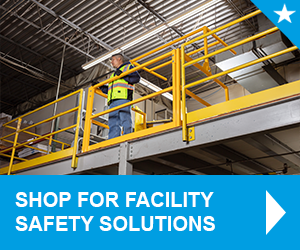
No matter how complex requirements become, it’s important to never lose sight of the basics laid out by the Occupational Safety and Health Administration (OSHA). Of course, you must know your local fall safety standards inside and out, but that’s much harder to do without maximum clarity on the fundamentals. Here, we’ll review the most consistent fall hazards found in manufacturing facilities, industrial sites, gas and alternative energy plants, commercial rooftops, and countless other work sites – all of which require extensive OSHA compliant fall protection measures.
Where OSHA Fall Protection Standards Apply
As the leading safety hazard in the construction industry, workplace falls receive a huge portion of the OSHA’s attention and resources. They’ve set numerous fall-protection standards applicable in numerous states that have adopted federal standards for workplace safety. Other states set their own local guidelines, which nevertheless usually mirror the federal guidelines, especially the foundational elements.
Finding Consistency in Fall Protection Standards
For any workplace safety concern, it’s essential that you achieve maximum compliance by consulting the specific OSHA, CCOHS, or state/local guidelines in your jurisdiction.
What you’ll find is that many of the same standards continually arise. That’s your signal to pay close attention and ask yourself where those conditions exist at your jobsite or facility. As we’ll explain, fall protection extends far beyond working at enormous heights or harness/lanyard situations. In fact, the vast majority of OSHA fall-protection regulations begin at only four feet.
What Are OSHA’s Exact Fall Protection Thresholds?
That depends on your industry, but for most companies, the threshold is only four feet. There are some exceptions, and the exact standards are as follows:
- Four feet for general industry workplaces
- Five feet at shipyards
- Six feet in the construction industry
- Eight feet for longshoring operations
In some cases, OSHA’s fall protection standards apply with no vertical height at all. That’s because the term “fall protection” also extends to certain other fall risks associated with tripping and other environmental hazards. These include:
- Working over or around dangerous equipment
- Holes and other compromised floor conditions
- Areas surrounding the base of ladders and stairways
Altogether, these are the most common areas addressed by fall protection regulations. They apply to an almost limitless number of locations, ranging from mezzanines, loading docks, and elevated work platforms of any kind.
Maximizing Fall Safety
When you view work sites with these basics in mind, they reveal potential fall hazards you might never have considered. By widening your understanding of what a fall hazard can be, you can see how even small obstacles could spell disaster for workers, especially when they endure heavy workloads, fatigue or other unforeseen distractions.
With your support, however, workers can have precautions in place that help them stay safe on the job. Self-closing gates, easily installed guardrails and clearly identifiable safety devices and more all go a long way in maximizing workplace safety, and every little detail counts.
Foundational Safety Devices for the Most Common Fall Protection Needs
Guardrails
As many facilities require fall protection anywhere with a four-foot drop or around potentially dangerous equipment, most labor-intensive businesses require an extensive guardrail system.
That’s why modular guardrail systems are becoming increasingly popular: They provide greater utility due to a number of user-friendly features:
- Easy, one-tool installation
- Interchangeable components
- Expandability
- Compatibility with a wide range of different railings and fittings
The most advanced modular guardrail systems on the market also provide equally effective fall protection, compared to standard guardrails. It modular rails provide greater versatility, and with no appreciable loss in function.
Safety Gates
There are numerous types of safety gates designed for a broad range of specific and general use cases. The most innovative gate designs use a variety of latching mechanisms, mounts and force controls to expand versatility.
For instance, self-closing industrial swing gates give employees one less thing to worry about. It not only improves safety but ensures proper gate operation every time. In cases where swing space is limited, vertical lift gates are a good alternative, maintaining maximum floor space availability whether open or closed.
The most common places vertical lift or industrial swing gates are required include:
- Loading docks
- Access points for dangerous equipment
- Stairways
- Ladders
In most cases, stairways and ladders require safety gates at both the top and bottom. This is to ensure workers slow down and assess the area before ascending or descending. Here, it’s also important to maintain proper lighting and clear, visible textures and colors so workers have clear visual cues of where the change in elevation begins.
Mezzanines
To maximize space, warehouses often store pallets and other resources in elevated storage areas. It improves efficiency, but also requires further safety considerations, such as a mezzanine or pallet gate to facilitate loading and unloading.
Made for both single- and double-pallet widths, mezzanine gates provide a reliable means of temporarily providing access to an elevated platform in a tightly controlled way. They utilize a dual-gate system that opens only one side at a time, as follows:
- The outer gate opens to accommodate the incoming load
- Once received, the first gate closes. The second gate, on the inside of the mezzanine, then opens to provide workers access to the load
Note that OSHA compliant fall protection also applies to protecting workers below elevated workspaces. Along with an efficient and reliable pallet gate, it’s important to install toe guards to prevent tools and debris from falling.
Maximizing Fall Protection with Minimal Difficulty
Fall protection regulations can be incredibly nuanced, especially in unique situations. Yet for many businesses, the basic standards can be met with versatile fall protection barriers that are as user-friendly as they are tough and reliable.
For over 45 years, Fabenco has continually advanced the fall protection systems in use throughout countless industries. If you’d like help comparing our industrial swing gates, modular guardrail systems, or pallet gates, contact us. We can help you find the right OSHA compliant fall protection system for your exact needs and achieve widespread workplace safety and efficiency.





